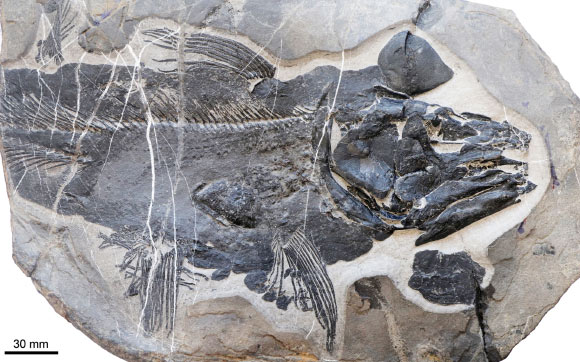Paleontologists in China have described a new species of the coelacanth genus Whiteia on the basis of two fossilized specimens. This discovery extends the spatial range of Whiteia in the Early Triassic, and documents the oldest species of the genus in Asia, predating the previously oldest record of whiteiid coelacanths in this continent by 9 million years.

Whiteia anniae in right lateral view, holotype. Image credit: Dai et al., doi: 10.1038/s41598-025-20229-w.
“Coelacanths are a curious group of sarcopterygian fishes, represented by two extant marine species in the genus Latimeria,” said lead author Dr. Guang-Hui Xu, a paleontologist with the Institute of Vertebrate Paleontology and Paleoanthropology at the Chinese Academy of Sciences, and colleagues.
“This group was first known in the Early Devonian, reached their peak of taxonomic diversity during the Early Triassic, but declined after the mid-Cretaceous.”
“Coelacanths are highly significant in evolutionary biology for their unique combination of physiological and anatomical characteristics and their ability to survive four major extinction events over hundreds of millions of years.”
“The discovery of Latimeria once ignited a debate about how this bizarre lobe-finned fish fits into the evolution of land animals.”
“Because of evolutionary conservatism, coelacanths have long been considered one of the most morphologically conservative vertebrate groups.”
“However, several studies, especially those based on Triassic fossils, have shown that coelacanth body shapes are more diverse than previously thought.”
“In recent years, new species recovered from fossil sites worldwide continually provide valuable evidence for investigating the coelacanth evolution.”
The new coelacanth species, named Whiteia anniae, lived about 249 million years ago during the Smithian age of the Early Triassic.
The fish belongs to Whiteia, a genus of extinct coelacanths previously known from Madagascar, South Africa, Canada and Greenland — but not from Asia.
“As the first record of Whiteia from the Early Triassic of Asia, the new finding considerably extends the spatial range of the genus and provides an important addition for our understanding the evolution of this major Triassic clade of coelacanths,” the paleontologists said.
Two specimens of Whiteia anniae were found in the Lower Triassic marine deposits exposed in Maoshankou in China’s Anhui province.
The fossils show that this coelacanth was between 41 and 46 cm in total body length — notably larger than other named species of its genus.
“The previously reported Whiteia species were generally small with a total length of 11.5 cm to 27 cm in the Early Triassic, and a small and slender body form was once considered characteristic of the genus,” the researchers said.
“Recently, the recovery of Whiteia giganteus (estimated total length of over 100 cm) from Texas reveals an episode of large body size acquisition of the genus in the Late Triassic of North America.”
“Our recovery of Whiteia anniae from China provides an interesting example that bridges the small species of Whiteia from Europe and Africa and those much larger relatives from North America in body size.”
The team’s paper was published on October 17 in the journal Scientific Reports.
_____
QH. Dai et al. 2025. A new coelacanth (Actinistia, Sarcopterygii) from the Early Triassic of Anhui, China. Sci Rep 15, 36320; doi: 10.1038/s41598-025-20229-w







